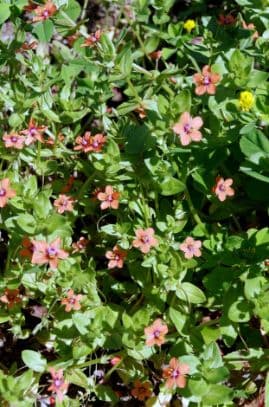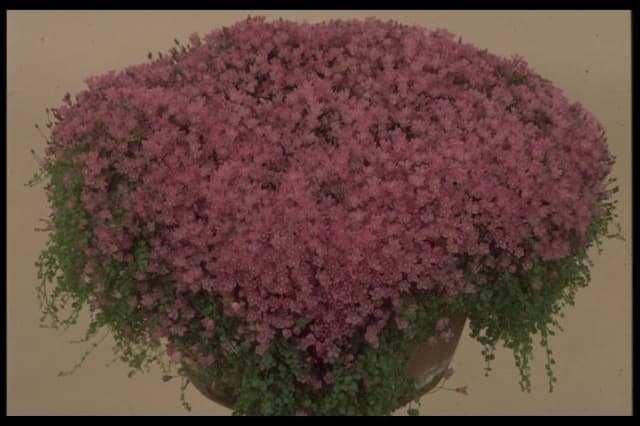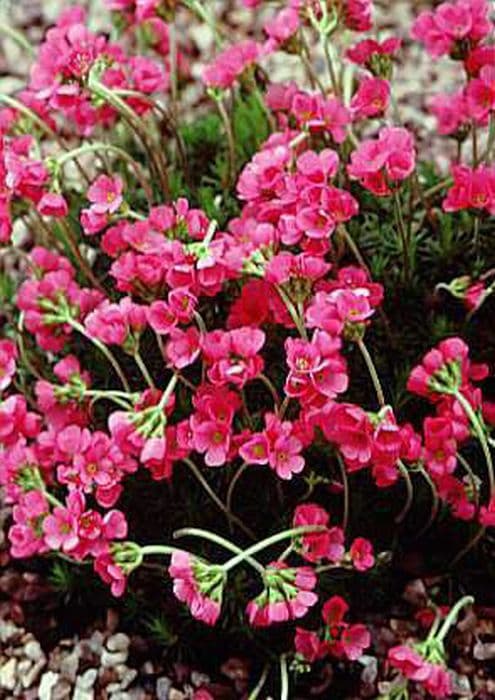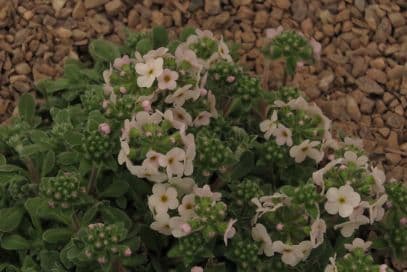Persian violet Cyclamen cilicium

ABOUT
Cyclamen cilicium, often referred to simply as Cyclamen, is a charming flowering plant appreciated for its beautiful and distinctive appearance. The foliage of Cyclamen cilicium is heart-shaped with a deep green color and often displays attractive silver marbling on the surface, giving it a decorative look even when the plant is not in bloom. These leaves emerge from a central tuber that remains partly hidden beneath the soil. The flowers of Cyclamen are its most remarkable feature. They bloom elegantly above the mound of foliage on slender stalks, with each flower having a unique swept-back petal shape. The petals can be described as reflexed, meaning they bend sharply backward, creating a look reminiscent of butterfly wings or windswept bonnets. The color of the flowers varies, often presenting shades of pink, magenta, or occasionally white, and they are characterized by a pleasant fragrance. Often found tucked within the foliage are the seed pods that develop after the flowers have been pollinated. These will gradually pull down towards the ground as they mature. The aesthetic appeal of Cyclamen cilicium, with its delicate flowers and attractive leaves, makes it a popular choice for ornamental gardening and as a houseplant.
About this plant
 Names
NamesFamily
Primulaceae
Synonyms
Cilician Cyclamen, Turkish Cyclamen
Common names
Cyclamen cilicium subsp. cilicium, Cyclamen cilicium var. cilicium.
 Toxicity
ToxicityTo humans
Cyclamen, specifically Cyclamen cilicium, contains saponins which can be toxic when ingested. If parts of the plant are consumed, symptoms of poisoning may include vomiting, diarrhea, and gastrointestinal upset. In severe cases, ingestion can lead to more serious effects, including heart rhythm abnormalities and seizures. It is advised to keep this plant out of reach of children and to seek medical attention if ingestion is suspected.
To pets
Cyclamen, when ingested by pets like dogs and cats, can be poisonous. The plant contains saponins, which are toxic to animals. Symptoms of poisoning can include vomiting, diarrhea, drooling, and a decrease in appetite. In severe cases, heart rhythm abnormalities, seizures, and even death can occur, particularly if a large amount of the plant is consumed. It is important to prevent pets from accessing this plant and to consult a veterinarian immediately if there are signs of cyclamen ingestion.
 Characteristics
CharacteristicsLife cycle
Perennials
Foliage type
Semi-deciduous
Color of leaves
Green
Flower color
Pink
Height
6 inches (15 cm)
Spread
6 inches (15 cm)
Plant type
Bulb
Hardiness zones
7
Native area
Turkey
Benefits
 General Benefits
General Benefits- Ornamental value: Cyclamen cilicium, commonly known as Cyclamen, adds aesthetic appeal to gardens and homes with its vibrant flowers and unique foliage.
- Attracts pollinators: The nectar-rich flowers attract bees, butterflies, and other beneficial pollinators, supporting local ecosystems.
- Seasonal interest: Cyclamen blooms from late summer to autumn, providing colour when many other plants have finished flowering.
- Shade tolerance: Cyclamen can thrive in shaded areas where other plants might struggle, making it a versatile choice for different garden spots.
- Drought resistance: Once established, it is relatively drought-tolerant, requiring minimal watering and care, making it suitable for xeriscaping.
- Easy propagation: Cyclamen can be easily propagated by seed or division, allowing gardeners to expand their collection without additional cost.
- Long flowering period: The plant has a long blooming period, which can last several weeks, ensuring prolonged enjoyment of its flowers.
 Medical Properties
Medical PropertiesThis plant is not used for medical purposes.
 Air-purifying Qualities
Air-purifying QualitiesThis plant is not specifically known for air purifying qualities.
 Other Uses
Other Uses- Cyclamen cilicium bulbs can be used to produce a starch-like substance for culinary uses, similar to how root vegetables like potatoes are processed.
- The patterned leaves of the Cyclamen can inspire artists and designers in creating textile patterns or artwork.
- In some cultures, the dried and powdered form of the tubers has been used as a laundry detergent alternative.
- The flowers of Cyclamen cilicium can be crystallized and used for decorative purposes on desserts and cakes.
- The plant can be used in fairy gardens as it provides an attractive, whimsical element with its heart-shaped leaves and distinctive flowers.
- During festive seasons, Cyclamen plants are often given as living gifts due to their beautiful foliage and flowers, signifying affection or deep love.
- Flowers from the Cyclamen, when pressed, are used for crafting handmade greeting cards or bookmarks, preserving their shape and color.
- Since Cyclamen cilicium goes dormant in summer, the withered foliage can be used to teach about the life cycles of plants in educational settings.
- The plant can be used in photography, notable for its vivid colors and patterns, as a subject for botanical illustration or close-up photography.
- Aesthetic garden design often incorporates Cyclamen cilicium for its ability to provide ground cover and winter bloom in temperate climates.
Interesting Facts
 Feng Shui
Feng ShuiThe Cyclamen is not used in Feng Shui practice.
 Zodiac Sign Compitability
Zodiac Sign CompitabilityThe Cyclamen is not used in astrology practice.
 Plant Symbolism
Plant Symbolism- Devotion and Sincerity: Cyclamen are often associated with deep and sincere devotion due to their heart-shaped leaves, symbolizing the love and dedication inherent in lasting relationships.
- Goodbye and Parting: The plant is also connected with sentiments of farewell or parting, making it suitable as a gift when someone is leaving or as an emblem for someone who wishes to convey their feelings at a departure.
- Resilience: Cyclamen's ability to endure in harsh conditions speaks to its representation of resilience and the spirit to survive and thrive despite challenges.
 Water
WaterCyclamen generally prefer to be watered when the top inch of soil feels dry to the touch, which typically means watering every 7 to 14 days, depending on environmental conditions. They should be watered from the bottom to avoid wetting the leaves, which can lead to fungal diseases. You can soak the pot in a tray with about one inch of water and allow the plant to absorb moisture for about 15 minutes. Once the topsoil is moist, remove any excess water from the tray to prevent root rot. Cyclamen need less water during their dormant period (typically in summer) and should be kept on the drier side.
 Light
LightCyclamen cilicium, commonly known as Cyclamen, thrives best in bright, indirect light. A north or east-facing window that provides some morning sun but shields the plant from intense afternoon light is ideal. Too much direct sunlight can cause the leaves to yellow and the flowers to fade quickly. Placing the plant in a spot with dappled sunlight, similar to its native environment, will promote healthy growth and flowering.
 Temperature
TemperatureCyclamen cilicium, commonly referred to as Cyclamen, prefers cooler temperatures, ideally between 60 to 70 degrees Fahrenheit. It can survive minimum temperatures down to about 50 degrees Fahrenheit but should not be exposed to temperatures above 77 degrees Fahrenheit for prolonged periods. The plant is sensitive to extreme heat and cold, so maintaining a stable, cool environment is crucial for its thriving.
 Pruning
PruningCyclamen cilicium, known simply as Cyclamen, requires pruning to remove yellow or dead leaves and spent flowers to encourage new growth and maintain a tidy appearance. This should be done as needed throughout the blooming season. The best time to prune is after the flowers have faded, typically in late winter or early spring. Gently pull off the leaves and flower stems close to the base without damaging the tuber.
 Cleaning
CleaningAs needed
 Soil
SoilThe Cilician cyclamen prefers well-draining soil rich in organic matter with a slightly acidic to neutral pH of 6.5 to 7.5. A mix of potting soil, perlite, and peat moss can create the ideal conditions for its growth. Adjust the soil mixture to ensure good aeration and avoid water-logging, which can lead to root rot.
 Repotting
RepottingCilician cyclamen should be repotted every 1-2 years, ideally when it's dormant during the summer. Fresh soil will replenish nutrients and provide room for root growth. Be gentle, as cyclamen have delicate tubers that can be easily damaged while repotting.
 Humidity & Misting
Humidity & MistingCilician cyclamen thrives in moderate to high humidity levels, ideally between 50% and 70%. Avoid placing the plant near heating vents or air conditioners which can dry out the air and adversely affect the plant.
 Suitable locations
Suitable locationsIndoor
Place in bright, indirect light; keep soil moist but not soggy.
Outdoor
Plant in dappled shade; avoid waterlogged soil, protect from frost.
Hardiness zone
5-9 USDA
 Life cycle
Life cycleCyclamen cilicium, commonly known as Cilician cyclamen, begins its life as a tuber, which sprouts roots, leaves, and flowers as temperatures cool in the fall. The heart-shaped leaves emerge first, followed by the fragrant pink flowers with upturned petals which typically bloom from late autumn to early winter. After pollination, often by insects, the flowers develop into seed pods which are drawn below the ground as they mature. The seeds are distributed as the pod ruptures, giving rise to new plants. In the summer, the plant enters a period of dormancy as the leaves die back and the tuber rests underground until the next autumn. The cycle repeats annually with the tuber expanding and gradually producing larger and more plentiful flowers as the plant matures over the years.
 Propogation
PropogationPropogation time
Autumn-Winter
Cyclamen cilicium, commonly known as Turkish Cyclamen, is typically propagated through seed sowing. The best time to propagate by seed is in the fall, after the mature capsules split open. The seeds can be sown in a well-drained potting mix, lightly covered with soil or vermiculite. It's crucial to maintain a consistent moisture level without waterlogging the soil, which can be achieved by watering with a gentle spray. Environmental conditions should be cool, mirroring the plant's natural habitat. Seedlings usually emerge in several weeks to a few months and require careful handling due to their delicate nature. After the seedlings have developed a couple of sets of leaves and have strengthened, they can be transplanted into individual pots.









